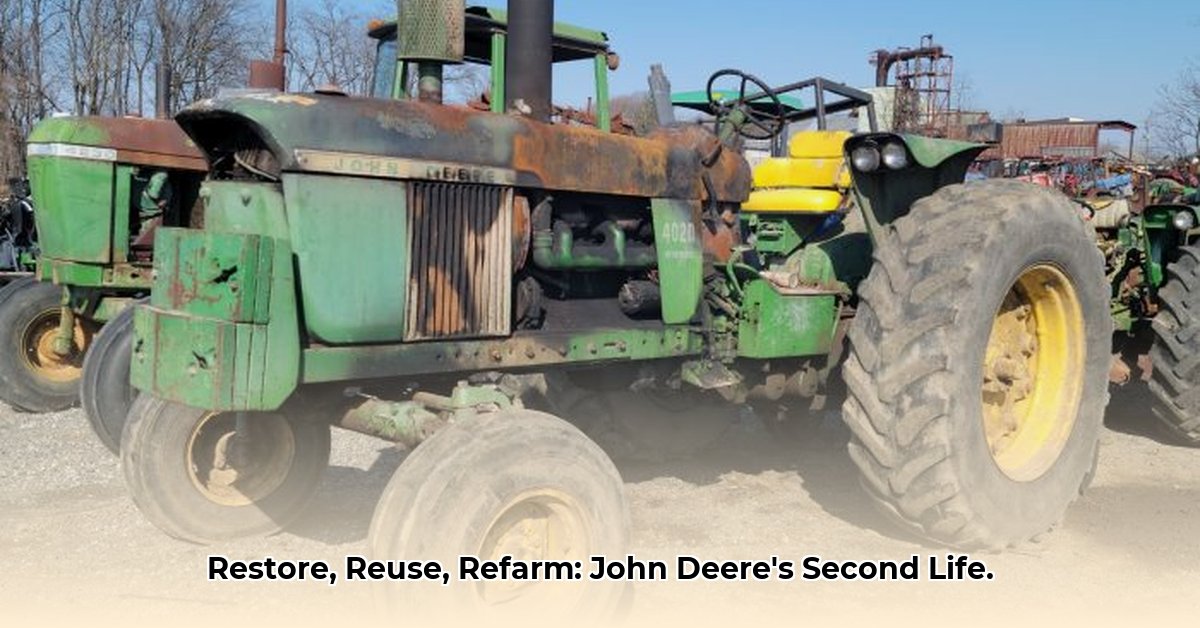
Finding affordable and environmentally friendly ways to maintain your John Deere tractor is crucial for modern farming. The John Deere tractor salvage parts market offers significant cost savings and promotes sustainable agriculture, but navigating this market requires careful planning. This guide will equip you with the knowledge and strategies to successfully source and utilize salvage parts, contributing to a more sustainable and economically viable farming operation. For more information on John Deere tractors, visit this helpful resource.
Understanding the John Deere Tractor Salvage Market
The demand for used John Deere parts is rapidly expanding. Farmers are increasingly recognizing the substantial financial benefits and environmental advantages of using salvaged parts. The market offers a wide range of components, from small fasteners to major engine assemblies. Pricing varies considerably, depending on the part's condition, rarity, and the seller's reputation. Common parts for newer models are generally more readily available and affordable than rare components for older models. Major sources include online marketplaces (like eBay) and local salvage yards, each presenting unique advantages and challenges. 1
Assessing Part Quality: A Critical Inspection Process
Before purchasing any used part, a thorough inspection is paramount. This minimizes the risk of costly mistakes and ensures the salvaged parts meet your operational standards. A multi-stage process will yield the highest confidence in the component's integrity:
Step-by-Step Inspection
- Visual Examination: Begin with a comprehensive visual inspection, scrutinizing the part for cracks, significant wear, excessive rust, or any signs of damage. Pay close attention to areas subject to stress during operation.
- Physical Assessment: Carefully examine all surfaces and components. In the case of moving parts, check for play or looseness. If possible, safely test functionality and listen for unusual sounds.
- Corrosion Assessment: Rust is a major concern. Extensive corrosion compromises structural integrity. While some surface rust might be manageable, significant rust usually renders a part unusable.
- Part Number Verification: Double-check the part number against your tractor's specifications. Mismatched numbers lead to compatibility issues. Refer to your tractor's manual or online parts diagrams.
- Third-Party Certification: While not always available, seek parts with certifications from reputable inspection agencies. These certifications offer a significant enhancement to the perceived part quality.
Navigating the Supply Chain: Identifying Reputable Suppliers
Finding reliable suppliers is crucial for successful salvage part sourcing. Online marketplaces offer ease of access but require caution. Always check seller ratings and reviews thoroughly, examining feedback regarding quality, responsiveness, and shipping practices. Scrutinize listings for clear, detailed descriptions and high-quality photos. Before purchasing, ask the seller pertinent questions about the part’s history, operational condition, and warranty. For greater confidence, consider visiting local salvage yards personally to inspect parts firsthand before committing to a purchase.
Long-Term Sustainability: Environmental and Economic Considerations
Utilizing salvage parts is a significant step toward sustainable and environmentally responsible farming. It reduces the demand for new parts, conserving valuable resources and minimizing manufacturing energy consumption. However, proper disposal of unusable parts is equally vital. Improper disposal leads to environmental damage. Adhere to local regulations and ensure the appropriate recycling and waste management procedures are followed. Collaboration between farmers, suppliers, and manufacturers is vital to establish industry-wide sustainable practices.
Actionable Steps for Key Stakeholders
The success of the salvage market hinges on collective action. Different stakeholders have unique roles and responsibilities in promoting sustainability and transparency:
| Stakeholder | Short-Term Actions | Long-Term Actions |
|---|---|---|
| Farmers | Thoroughly inspect parts; verify compatibility; seek expert advice when uncertain; purchase from reputable sellers. | Develop a preventative maintenance program; establish relationships with trustworthy suppliers; invest in tractor diagnostic tools. |
| Salvage Yard Operators | Implement rigorous quality checks; offer clear warranties; enhance online presence with detailed part descriptions and high-quality images. | Invest in inventory management systems; prioritize environmentally friendly disposal practices; collaborate on industry standards. |
| John Deere Dealerships | Provide parts compatibility advice; consider part exchange programs for obsolete components; develop helpful online resources. | Actively promote the use of salvage parts; collaborate with salvage yards to ensure part quality and availability. |
| Government Agencies | Promote transparency and traceability in the salvage market; enforce appropriate disposal regulations. | Develop industry standards for used parts; support research and development of more durable and easily repairable equipment. |
Conclusion: Embracing a Sustainable Future
The John Deere tractor salvage market offers tremendous potential for cost savings and environmental sustainability within the agricultural sector. However, realizing this potential demands increased transparency, standardized practices, and collaborative efforts across the entire supply chain. By adopting these strategies, farmers can build a more economically viable and environmentally responsible future.